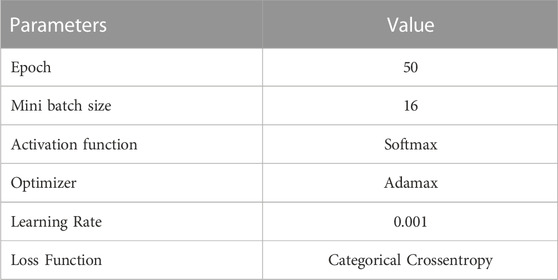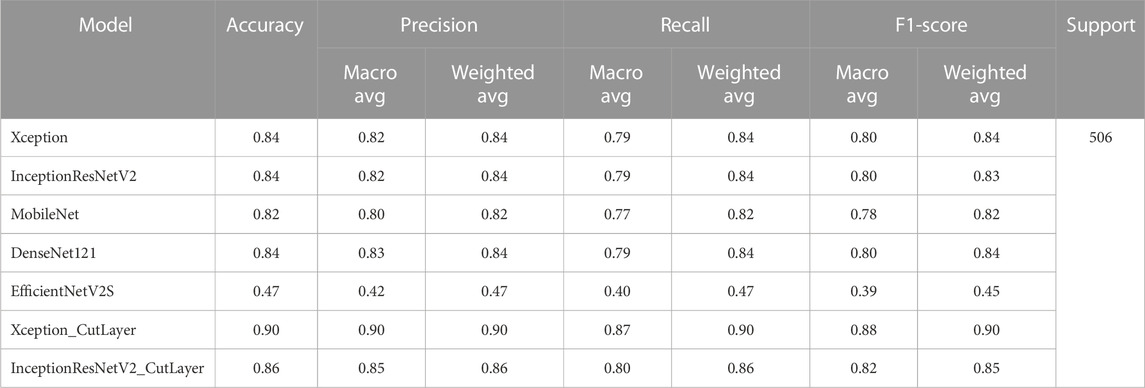- Department of Computer Engineering, Faculty of Engineering and Architecture, Erzincan Binali Yıldırım University, Erzincan, Türkiye
In today’s conditions, where the human population is increasing, environmental pollution is also increasing around the world. One of the most important causes of environmental pollution is the waste materials in the garbage. Misuse of waste materials causes significant damage to both the environment and human health. With the developing technology, the recyclability of the raw material used in the production of waste materials significantly affects both the raw material needs of the countries and the energy savings. Therefore, many traditional activities are carried out in recycling facilities in order to reuse the waste materials that can be recycled in many countries. At the beginning of these activities is manual waste collection and pre-processing depending on the human workforce. This process poses a serious threat to both the environment and human health. For this reason, there is a need for a smart system that automatically detects and classifies the waste materials in the garbage. In this study, Xception, InceptionResNetV2, MobileNet, DenseNet121 and EfficientNetV2S deep learning methods based on artificial intelligence, which automatically classify the waste materials in the garbage, were used and in addition to these methods, Xception_CutLayer and InceptionResNetV2_CutLayer based on transfer learning techniques were proposed. The proposed methods and artificial intelligence-based deep learning methods were trained and tested with a dataset containing 6 different waste materials. According to the findings obtained as a result of training and testing, a classification success rate of 89.72% with the proposed Xception_CutLayer method and 85.77% with the InceptionResNetV2_CutLayer method, a better success rate was obtained than the other artificial intelligence-based methods discussed in the study.
1 Introduction
With the development of technology, waste materials such as plastic, glass, paper, and metal, which preserve the food consumed by people, have been used frequently in recent years. These waste materials become garbage accumulations resulting from the food consumed by people, threatening both the environment and human health significantly (Cao and Xiang, 2020; Carolis et al., 2020). These waste materials have become an important problem for countries and accordingly, waste materials have started to be produced as recyclable in many countries (Rabano et al., 2018; Yuan et al., 2020). These recyclable waste materials provide sustainable development by both reducing the raw material needs of the countries and significantly affecting energy savings (Meng and Chu, 2020; Kuang, and Lin, 2021; Peng et al., 2021). Therefore, recycling facilities have been established in many countries to reuse waste materials. Detection and classification of waste materials in these recycling facilities is a difficult and costly process since it is based on human labor (Ozkaya and Seyfi, 2019; Dong, 2021; Patel et al., 2021). In addition, the separation of human labor and waste materials both affect human health negatively and cause environmental pollution (Ma and Zhu, 2021). Therefore, it is of great importance for both the environment and human health to separate the waste materials in the garbage accumulated in the recycling facilities by using a robot system (Chandra et al., 2021; Cai et al., 2022). In recent years, with the development of artificial intelligence methods, object detection and classification within a certain garbage image are performed and satisfactory successes are achieved (Wu et al., 2021; Chen et al., 2022; Liu et al., 2022). In this way, both labor costs are reduced and more efficient processes are obtained (Tong et al., 2020). In this context, deep learning methods developed with artificial intelligence technology in recent years have started to be used in many application areas that make object detection and classification and have provided important developments (Zeng et al., 2020; Yang et al., 2021; Zhang et al., 2021; Tan et al., 2022; Xiao and Sun, 2022; Zhan et al., 2022; Akgül, 2023).
This study, it is aimed to detect and classify waste materials in the garbage by using artificial intelligence-based Xception, InceptionResNetV2, MobileNet, DenseNet121, and EfficientNetV2S deep learning methods. For this purpose, in addition to the Xception, InceptionResNetV2, MobileNet, DenseNet121 and EfficientNetV2S deep learning architectures, 2 different deep learning methods named Xception_CutLayer and InceptionResNetV2_CutLayer have been proposed. The proposed methods are obtained by applying block cutting to Xception and InceptionResNetV2 methods, which are accepted in the artificial intelligence-based literature. In this way, 2 new models based on the transfer learning technique with less complexity were proposed by reducing both the number of layers and accordingly the number of parameters. These proposed methods and 5 different deep learning methods discussed in the study were trained and tested using the Trashnet dataset containing 6 different garbage types. As a result of training and testing, the experimental results obtained from all deep learning methods were compared and the best method discussed in the study was determined. The global contributions of this study can be summarized as follows.
1. Waste materials are recycled, reducing the damage to the environment.
2. Efficiency is increased by recycling waste materials.
3. Excessive consumption of natural resources is prevented.
4. Soil fertility and the quality of life of living things increase.
5. A cleaner environment is provided by reducing the amount of garbage.
6. Contribution is made to the economies of countries.
The remainder of the study is organized as follows. In Section 2, studies that identify and classify waste materials in garbage are reviewed and discussed. The study and materials and methods are presented in Section 3, and the experimental results and discussions are presented in detail in Section 4. In Section 5, detailed information about the results of the study and future studies is given.
2 Related works
In this section, recent studies on the identification and classification of waste materials in garbage are examined in detail.
In their study, Endah and Shiddiq performed garbage classification using the pre-trained VGG16, ResNet-50, and Xception models TrashNet dataset, and an 88% success rate was obtained with the Xception model (Endah and Shiddiq, 2020). Fu et al., in their study, developed an intelligent garbage classification system based on deep learning and Linux system using the Huawei Garbage Classification Challenge Cup dataset. In this developed system, they achieved a success rate of 92.62% in garbage classification (Fu et al., 2021).
Chen and Xiong proposed a structure that detects 15 objects based on the Yolov4 model structure, achieving a 64% success rate (Chen and Xiong, 2020). Yang and Li proposed a new garbage classification system in their study. ImageNet, Garbage Classification, and TrashNet datasets were used for the proposed system and they achieved classification success rates of 64.5%, 82.5%, and 96.10%, respectively (Yang and Li, 2020). Kang et al., proposed a garbage classification system based on the ResNet-34 deep learning algorithm using online and real-life image datasets, and they achieved a 99% classification success rate (Kang et al., 2020). Qin, et al., proposed a structure combining salience detection and image recognition for garbage classification from images with complex backgrounds and obtained better results (Qin, et al., 2022). Meng et al., in their study, proposed a new model (X-DenseNet) by combining Xception and DenseNet deep learning architectures. The proposed model was trained using a dataset consisting of 6 different (glass, paper, cardboard, plastic, metal, and other trashes) garbage and achieved a garbage classification success rate of 94.1% (Meng et al., 2020).
Zhao et al., in their study, proposed an intelligent garbage classification system based on MobileNetV3-Large, which can both classify garbage images and classify garbage text. The proposed system classified garbage images with an accuracy of 81% and texts with an accuracy of 97.61% (Zhao et al., 2022). Sürücü and Ecemiş compared pre-trained EfficientNetB7, InceptionV3, NASNet-Large, ResNet50, and Resnet50-V2 model structures using garbage datasets belonging to 6 different classes in their study. As a result of the comparison, the most successful garbage classification model, the Resnet50-V2 model, has a success rate of 97.07% (Sürücü and Ecemiş, 2022). Luo et al., proposed an edge-cloud method using a deep convolutional neural network to classify recyclable garbage. With this proposed method, it has been tested using garbage images consisting of real-life data and 90% success accuracy has been achieved (Luo et al., 2021).
3 Materials and methods
3.1 Dataset and image pre-processing
In the study, a Trashnet dataset (Yang and Thung, 2016; Github, 2023) containing 6 different garbage types was used to classify the wastes in the garbage by using artificial intelligence-based Xception (Chollet, 2017), InceptionResNetV2 (Szegedy et al., 2017), MobileNet (Howard et al., 2017), DenseNet121 (Huang et al., 2017) and EfficientNetV2S (Tan and Le, 2021) deep learning methods and in addition to these methods, Xception_CutLayer, and InceptionResNetV2_CutLayer methods. In this dataset, 582 × 384 × 3 pixels, 403 pieces of cardboard, 501 pieces of glass, 410 pieces of metal, 594 pieces of paper, 482 pieces of plastic, and 137 pieces of other trash contains a total of 2527 image data. In Figure 1, there are sample images of each garbage type in the dataset.
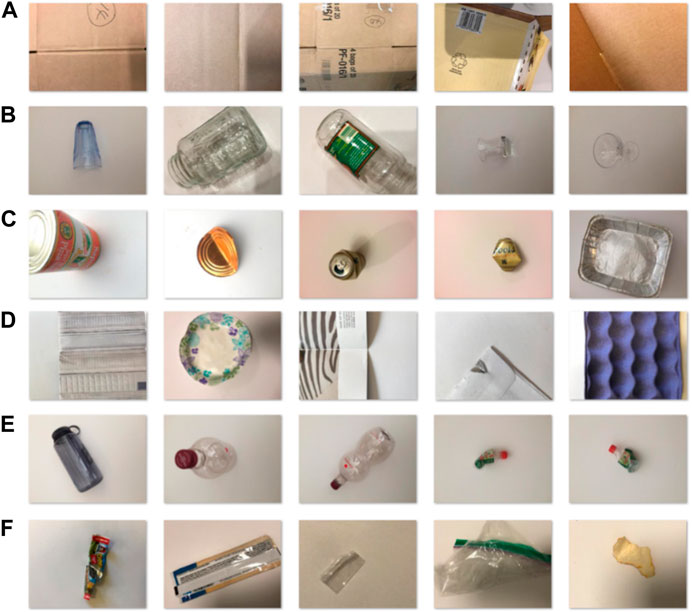
FIGURE 1. Sample images of each garbage type in the dataset (A) cardboard (B) glass (C) metal (D) paper (E) plastic (F) trash.
In order to successfully classify 6 different garbage types in the dataset, new images with 224 × 224×3 pixels were obtained by preprocessing each garbage image.
3.2 System configuration
In order to obtain successful classification results from the new dataset obtained as a result of the preprocessing, the design, implementation, and analysis of each model structure discussed in the study were made using the Python programming language in a Google Colaboratory (Colab, 2023) environment with NVIDIA Tesla K80 graphics processor.
3.3 Model structure and training parameters
In the study, Xception, InceptionResNetV2, MobileNet, DenseNet121, and EfficientNetV2S deep learning methods based on artificial intelligence were discussed in order to obtain successful classification results from the dataset with waste material images in the garbage. Two deep learning methods based on transfer learning techniques named Xception_CutLayer and InceptionResNetV2_CutLayer have been proposed by applying block cutting to Xception and InceptionResNetV2 models. An output matrix with the size of 7 × 7 × 1024 is obtained by applying 1 block (block 14) shearing to the Xception model. In the same way, an output matrix of 5 × 5 × 2080 is obtained by cutting 10 blocks (from blocks 8_1 to blocks 8_10) on the InceptionResNetV2 model. According to these output matrices, Xception_CutLayer and InceptionResNetV2_CutLayer model structures with better classification performance than both Xception and InceptionResNetV2 model structures were obtained. These model structures have been transformed from Xception and InceptionResNetV2 model structures, which are accepted in the literature, to simpler model structures in terms of both complexity and runtime. The diagram of the proposed Xception_CutLayer and InceptionResNetV2_CutLayer model structures is given in Figure 2.
The Trashnet dataset is divided into the datasets given in Table 1 in detail in order to successfully perform the training processes of both the artificial intelligence-based methods and the proposed 2 deep learning methods. Using these datasets, the training and testing of the models were carried out. In addition, hyperparameters detailed in Table 2 were used to train and test each model structure.
4 Results and discussion
4.1 Classification metrics
Classification metrics are used to compare classification results obtained from various methods. Precision, recall, F1-score, and accuracy metrics were used to determine the performance of each method in the study in the classification of waste materials in the garbage. The mathematical expressions given in equations (1–4) were used to calculate the metrics considered.
Here, TP, FP, TN, and FN are true positive, false positive, true negative, and false negative, respectively.
4.2 Performance analysis
In this section, training and testing of Xception, InceptionResNetV2, MobileNet, DenseNet121, EfficientNetV2S, Xception_CutLayer, and InceptionResNetV2_CutLayer methods were carried out in order to successfully classify waste materials in the garbage.
According to the datasets given in Section 2.1 and the hyperparameter values used in Section 2.3, the training process of each deep learning method discussed in the study was carried out using the transfer learning technique. The training success accuracy graphs obtained as a result of transfer learning of these methods are given in Figure 3, and the loss graphs are given in Figure 4. In order to determine that the model structures are more successful in classifying the waste materials in the garbage, the numerical results of each model are given in Table 3 comparatively and the confusion matrix graphics obtained from these numerical results are given in Figure 5.
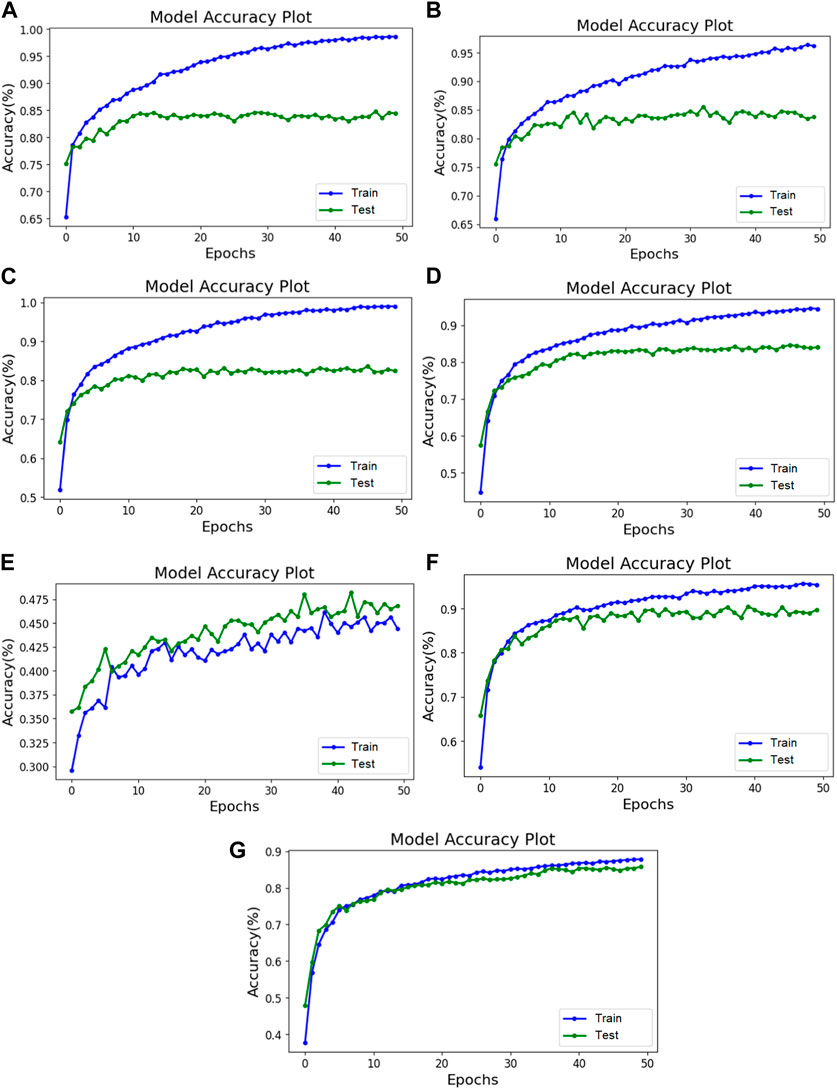
FIGURE 3. Train-test accuracy graph of each deep learning method (A) Xception (B) InceptionResNetV2 (C) MobileNet (D) DenseNet121 (E) EfficientNetV2S (F) Xception_CutLayer (G) InceptionResNetV2_CutLayer.

FIGURE 4. Train-test loss graph of each deep learning method (A) Xception (B) InceptionResNetV2 (C) MobileNet (D) DenseNet121 (E) EfficientNetV2S (F) Xception_CutLayer (G) InceptionResNetV2_CutLayer.
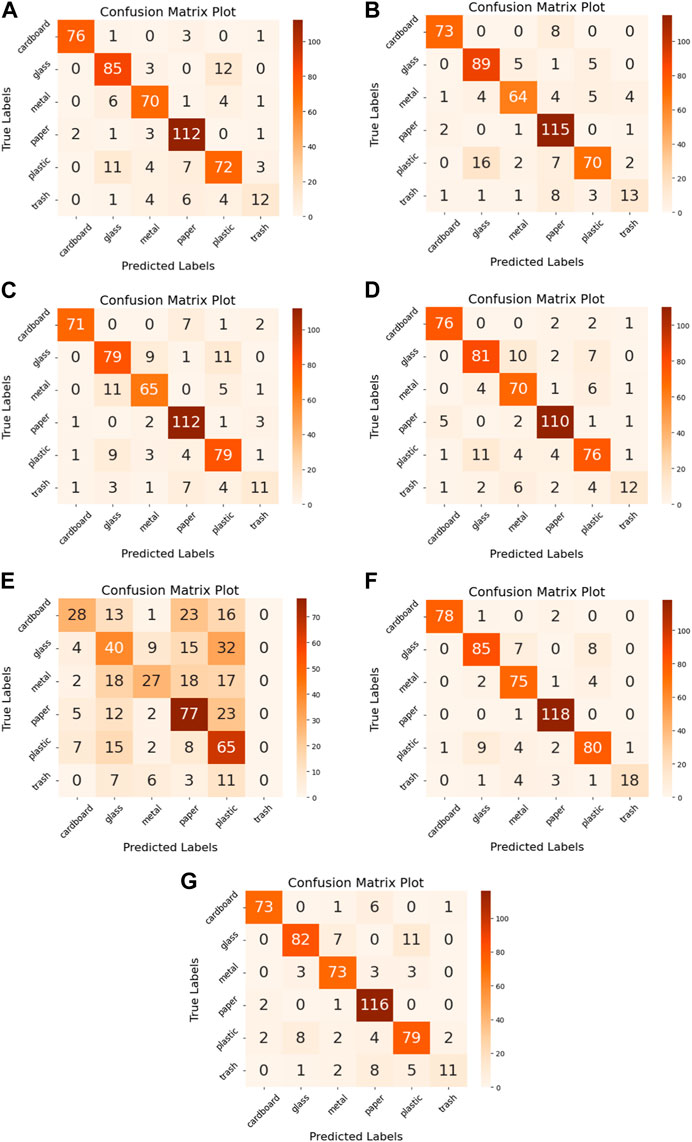
FIGURE 5. Confusion matrix plot of each deep learning method according to the test dataset (A) Xception (B) InceptionResNetV2 (C) MobileNet (D) DenseNet121 (E) EfficientNetV2S (F) Xception_CutLayer (G) InceptionResNetV2_CutLayer.
In the study, the accuracy, loss, and confusion matrix findings obtained from artificial intelligence-based methods and deep learning methods in the classification of waste materials in the garbage were discussed and analyzed comparatively under the same conditions. According to these findings, the Xception model structure, which is used in the classification of waste materials in the garbage and has approximately 20.88 M parameters, was trained in an average of 550 s, and as a result of the training, 98.61% training, 84.39% testing and 0.4232 loss success rates were obtained. The InceptionResNetV2 model structure with approximately 54.35 M parameters was trained in an average of 850 s, and as a result of the training, 96.14% training, 83.79% testing, and 0.5412 loss success rates were obtained. The MobileNet model structure with approximately 3.23 M parameters was trained in an average of 175 s, and as a result of the training, 99.01% training, 82.41% testing, and 0.4755 loss success rates were obtained. The DenseNet121 model structure with approximately 7.04 M parameters was trained in an average of 475 s, and as a result of the training, 94.46% training, 83.99% testing, and 0.4545 loss success rates were obtained. The EfficientNetV2S model structure with approximately 20.34 M parameters was trained in an average of 600 s, and as a result of the training, 44.43% training, 46.84% testing, and 1.3641 loss success rates were obtained.
The proposed Xception_CutLayer model structure with approximately 16.11 M parameters was trained in an average of 500 s, and as a result of the training, 95.40% training, 89.72% testing, and 0.3182 loss success rates were obtained. The proposed InceptionResNetV2_CutLayer model structure with approximately 30.79 M parameters was trained in an average of 725 s, and as a result of the training, 87.88% training, 85.77% testing, and 0.5020 loss success rates were obtained. Therefore, according to the findings, the waste materials in the garbage were classified with the Xception, InceptionResNetV2, MobileNet, DenseNet121, EfficientNetV2S, Xception_CutLayer, and InceptionResNetV2_CutLayer model structures with success rates of 84.39%, 83.79%, 82.41%, 83.99%, 46.84%, 89.72%, and 85.77%, respectively. According to these results, it was concluded that the training and test success accuracies of the artificial intelligence-based Xception, InceptionResNetV2, MobileNet, DenseNet121 and EfficientNetV2S model structures discussed in the study were not fully consistent throughout the training process, in other words, the rate of misclassification increased. This situation was observed in the classification confusion matrix obtained from each artificial intelligence-based model structure. It is seen that the proposed Xception_CutLayer and InceptionResNetV2_CutLayer model structures have consistent training and test success accuracy throughout the training. In other words, it was concluded that the rate of misclassification decreased in the classification of waste materials in the garbage. Thus, thanks to the proposed 2 new deep learning model structures, classification error rate, training time, the number of parameters, and complexity are reduced.
5 Conclusion
In this study, a dataset consisting of cardboard, glass, metal, paper, plastic, and trash was used to classify waste materials in garbage based on sustainable development. In order to successfully classify the waste materials in this dataset, Xception, InceptionResNetV2, MobileNet, DenseNet121, and EfficientNetV2S deep learning methods based on transfer learning were used. In addition to these methods, 2 new methods based on transfer learning techniques named Xception_CutLayer and InceptionResNetV2_CutLayer have been developed by performing block cutting operations on Xception and InceptionResNetV2 methods. Both the developed methods and each artificial intelligence-based deep learning method discussed in the study were trained and tested under the same conditions. According to the experimental results obtained as a result of the training and testing processes of each method, the best classification success rate in the classification of waste materials in the garbage was 89.72% with the developed Xception_CutLayer model structure and 85.77% with the InceptionResNetV2_CutLayer model structure.
As a result, it was concluded that the success rates of the 2 new model structures developed in the study in classifying the waste materials in the garbage are higher than the other methods. In addition, it was concluded that the 2 new model structures developed were better than other methods in terms of parameter number, error rate, training time, and complexity. Therefore, the successful classification of the waste materials in the garbage by the 2 new model structures developed will contribute significantly to the recycling system.
This study has several limitations. First of all, when classifying waste materials in real-life applications, images with a clean background are often not used. Therefore, while classification of waste materials, classification is made on images with a more complex structure. For this reason, in order to obtain more precise classification results, complex dataset images should be used and the waste materials in these images should be identified and classified.
In the future, the number of images and waste material types in the dataset will be increased. In addition, cameras will be used to detect waste materials in more complex images, and the location and location of waste materials will be detected and classified in real-time.
Data availability statement
The original contributions presented in the study are included in the article/supplementary material, further inquiries can be directed to the corresponding author.
Author contributions
The author confirms being the sole contributor of this work and has approved it for publication.
Conflict of interest
The author declares that the research was conducted in the absence of any commercial or financial relationships that could be construed as a potential conflict of interest.
Publisher’s note
All claims expressed in this article are solely those of the authors and do not necessarily represent those of their affiliated organizations, or those of the publisher, the editors and the reviewers. Any product that may be evaluated in this article, or claim that may be made by its manufacturer, is not guaranteed or endorsed by the publisher.
References
Akgül, İ. (2023). A novel deep learning method for detecting defects in mobile phone screen surface based on machine vision. Sakarya Univ. J. Sci. 27 (2), 442–451. doi:10.16984/saufenbilder.1221346
Cai, X., Shuang, F., Sun, X., Duan, Y., Cheng, G., Sun, X., et al. (2022). Towards lightweight neural networks for garbage object detection. Sensors 22 (19), 7455–7517. doi:10.3390/s22197455
Cao, L., and Xiang, W. (2020). “Application of convolutional neural network based on transfer learning for garbage classification,” in 2020 IEEE 5th Information Technology and Mechatronics Engineering Conference (ITOEC), Chongqing, China, June 2020, 1032–1036. doi:10.1109/ITOEC49072.2020.9141699
Chandra, S. S., Kulshreshtha, M., and Randhawa, P. (2021). “Garbage detection and path-planning in autonomous robots,” in 2021 9th International Conference on Reliability, Infocom Technologies and Optimization (Trends and Future Directions) (ICRITO), Noida, India, September 2021, 1–4. doi:10.1109/ICRITO51393.2021.9596382
Chen, Q. Q., and Xiong, Q. H. (2020). Garbage classification detection based on improved YOLOV4. J. Comput. Commun. 8, 285–294. doi:10.4236/jcc.2020.812023
Chen, Z., Yang, J., Chen, L., Jiao, H., and Chen, L. (2022). Garbage classification system based on improved shufflenet v2. Resour. Conservation Recycl. 178, 106090–106111. doi:10.1016/j.resconrec.2021.106090
Chollet, F. (2017). “Xception: Deep learning with depthwise separable convolutions,” in Proceedings of the IEEE conference on computer vision and pattern recognition (CVPR), New York, NY, USA, July 2017, 1251–1258.
De Carolis, B., and Macchiarulo, F. N. (2020). “Yolo trashnet: Garbage detection in video streams,” in 2020 IEEE Conference on Evolving and Adaptive Intelligent Systems (EAIS), Bari, Italy, April 2020, 1–7. doi:10.1109/EAIS48028.2020.9122693
Dong, Z. (2021). Intelligent garbage classification system based on computer vision. Int. Core J. Eng. 7 (4), 147–152. doi:10.6919/ICJE.202104_7(4).0021
Endah, S. N., and Shiddiq, I. N. (2020). “Xception architecture transfer learning for garbage classification,” in 2020 4th International Conference on Informatics and Computational Sciences (ICICoS), Semarang, Indonesia, February 2020, 1–4. doi:10.1109/ICICoS51170.2020.9299017
Fu, B., Li, S., Wei, J., Li, Q., Wang, Q., Wei, J., et al. (2021). A novel intelligent garbage classification system based on deep learning and an embedded Linux system. IEEE Access 9, 131134–131146. doi:10.1109/ACCESS.2021.3114496
Github, (2023). Garythung. https://github.com/garythung/trashnet (Accessed April 10, 2023).
Google Colaboratory, (2023). Colab research. https://colab.research.google.com (Accessed April 20, 2023).
Howard, A. G., Zhu, M., Chen, B., Kalenichenko, D., Wang, W., Weyand, T., et al. (2017). Mobilenets: efficient convolutional neural networks for mobile vision applications. arXiv preprint, 1-9 https://arxiv.org/abs/1704.04861.
Huang, G., Liu, Z., Van Der Maaten, L., and Weinberger, K. Q. (2017). “Densely connected convolutional networks,” in Proceedings of the IEEE conference on computer vision and pattern recognition (CVPR), New York, NY, USA, May 2017, 4700–4708.
Kang, Z., Yang, J., Li, G., and Zhang, Z. (2020). An automatic garbage classification system based on deep learning. IEEE Access 8, 140019–140029. doi:10.1109/ACCESS.2020.3010496
Kuang, Y., and Lin, B. (2021). Public participation and city sustainability: Evidence from urban garbage classification in China. Sustain. Cities Soc. 67, 102741–102811. doi:10.1016/j.scs.2021.102741
Liu, W., Ouyang, H., Liu, Q., Cai, S., Wang, C., Liu, Q., et al. (2022). Image recognition for garbage classification based on transfer learning and model fusion. Math. Problems Eng. 2022, 1–12. doi:10.1155/2022/4793555
Luo, Q., Lin, Z., Yang, G., Zhao, X., and Yang, G. (2021). Dec: A deep-learning based edge-cloud orchestrated system for recyclable garbage detection. Concurrency Comput. Pract. Exp. 35, 1–8. doi:10.1002/cpe.6661
Ma, W., and Zhu, Z. (2021). Internet use and willingness to participate in garbage classification: An investigation of Chinese residents. Appl. Econ. Lett. 28 (9), 788–793. doi:10.1080/13504851.2020.1781766
Meng, S., and Chu, W. T. (2020). “A study of garbage classification with convolutional neural networks,” in 2020 Indo–Taiwan 2nd International Conference on Computing, Analytics and Networks (Indo-Taiwan ICAN), Rajpura, India, January 2020, 152–157. doi:10.1109/Indo-TaiwanICAN48429.2020.9181311
Meng, S., Zhang, N., Ren, Y., and Ren, Y. (2020). X-DenseNet: Deep learning for garbage classification based on visual images. J. Phys. Conf. Ser. 1575 (1), 012139–12146. doi:10.1088/1742-6596/1575/1/012139
Ozkaya, U., and Seyfi, L. (2019). Fine-tuning models comparisons on garbage classification for recyclability. arXiv preprint, 1-4 https://arxiv.org/abs/1908.04393.
Patel, D., Patel, F., Patel, S., Patel, N., Shah, D., Patel, V., et al. (2021). “Garbage detection using advanced object detection techniques,” in 2021 International Conference on Artificial Intelligence and Smart Systems (ICAIS), Coimbatore, India, August 2021, 526–531. doi:10.1109/ICAIS50930.2021.9395916
Peng, H., Shen, N., Ying, H., and Wang, Q. (2021). Factor analysis and policy simulation of domestic waste classification behavior based on a multiagent study—taking shanghai's garbage classification as an example. Environ. Impact Assess. Rev. 89, 106598–106612. doi:10.1016/j.eiar.2021.106598
Qin, J., Wang, C., Ran, X., Yang, S., Chen, B., Ran, X., et al. (2022). A robust framework combined saliency detection and image recognition for garbage classification. Waste Manag. 140, 193–203. doi:10.1016/j.wasman.2021.11.027
Rabano, S. L., Cabatuan, M. K., Sybingco, E., Dadios, E. P., and Calilung, E. J. (2018). “Common garbage classification using mobilenet,” in 2018 IEEE 10th International Conference on Humanoid, Nanotechnology, Information Technology, Communication and Control, Environment and Management (HNICEM), Baguio City, Philippines, April 2018, 1–4. doi:10.1109/HNICEM.2018.8666300
Sürücü, S., Ecemiş, İ. N., and Ecemis, I. N. (2022). Garbage classification using pre-trained models. Eur. J. Sci. Technol. 36, 73–77. doi:10.31590/ejosat.1103628
Szegedy, C., Ioffe, S., Vanhoucke, V., Alemi, A., and Vanhoucke, V. (2017). Inception-v4, inception-resnet and the impact of residual connections on learning. Proc. AAAI Conf. Artif. Intell. 31 (1), 4278–4284. doi:10.1609/aaai.v31i1.11231
Tan, M., and Le, Q. (2021). “Efficientnetv2: Smaller models and faster training,” in Proceedings of the 38th International Conference on Machine Learning, New York, NY, USA, August 2021 (PMLR), 10096–10106.
Tan, Y., Guo, W., Yang, K., Huang, J., Yang, Z., Yang, K., et al. (2022). Design of intelligent garbage classification system based on internet of things technology. J. Phys. Conf. Ser. 2187 (1), 012020–12110. doi:10.1088/1742-6596/2187/1/012020
Tong, Y., Liu, J., Liu, S., and Liu, S. (2020). China is implementing “Garbage Classification” action. Environ. Pollut. 259, 113707–113712. doi:10.1016/j.envpol.2019.113707
Wu, Z., Zhang, D., Shao, Y., Zhang, X., Zhang, X., Feng, Y., et al. (2021). “Using YOLOv5 for garbage classification,” in 2021 4th International Conference on Pattern Recognition and Artificial Intelligence (PRAI), Yibin, China, March 2021, 35–38. doi:10.1109/PRAI53619.2021.9550790
Xiao, H., and Sun, D. (2022). “Garbage classification system based on deep learning,” in International Conference on Optics and Machine Vision (ICOMV 2022), Guangzhou, China, September 2022, 226–230. doi:10.1117/12.2635367
Yang, J., Zeng, Z., Wang, K., Zou, H., Xie, L., Wang, K., et al. (2021). GarbageNet: A unified learning framework for robust garbage classification. IEEE Trans. Artif. Intell. 2 (4), 372–380. doi:10.1109/TAI.2021.3081055
Yang, M., and Thung, G. (2016). Classification of trash for recyclability status. CS229 Proj. Rep. (1), 1–6.
Yang, Z., and Li, D. (2020). Wasnet: A neural network-based garbage collection management system. IEEE Access 8, 103984–103993. doi:10.1109/ACCESS.2020.2999678
Yuan, J. Y., Nan, X. Y., Li, C. R., and Sun, L. L. (2020). Research on real-time multiple single garbage classification based on convolutional neural network. Math. Problems Eng. 2020, 1–6. doi:10.1155/2020/5795976
Zeng, M., Lu, X., Xu, W., Zhou, T., and Liu, Y. (2020). “PublicGarbageNet: A deep learning framework for public garbage classification,” in 2020 39th Chinese Control Conference (CCC), Shenyang, China, January 2020, 7200–7205. doi:10.23919/CCC50068.2020.9189561
Zhan, Y., Xu, Y., Zhang, C., Xu, Z., and Guo, B. (2022). “An irregularly dropped garbage detection method based on improved YOLOv5s,” in Proceedings of the 4th International Symposium on Signal Processing Systems, Xi'an, China, September 2022, 7–13. doi:10.1145/3532342.3532344
Zhang, C., Zhang, X., Tu, D., Wang, Y., and Tu, D. (2021). Small object detection using deep convolutional networks: Applied to garbage detection system. J. Electron. Imaging 30 (4), 043013. doi:10.1117/1.JEI.30.4.043013
Keywords: artificial intelligence, deep learning, transfer learning, garbage, waste classification
Citation: Kaya V (2023) Classification of waste materials with a smart garbage system for sustainable development: a novel model. Front. Environ. Sci. 11:1228732. doi: 10.3389/fenvs.2023.1228732
Received: 25 May 2023; Accepted: 18 August 2023;
Published: 25 August 2023.
Edited by:
Linlin Xu, University of Waterloo, CanadaCopyright © 2023 Kaya. This is an open-access article distributed under the terms of the Creative Commons Attribution License (CC BY). The use, distribution or reproduction in other forums is permitted, provided the original author(s) and the copyright owner(s) are credited and that the original publication in this journal is cited, in accordance with accepted academic practice. No use, distribution or reproduction is permitted which does not comply with these terms.
*Correspondence: Volkan Kaya, dmtheWFAZXJ6aW5jYW4uZWR1LnRy
 Volkan Kaya
Volkan Kaya

